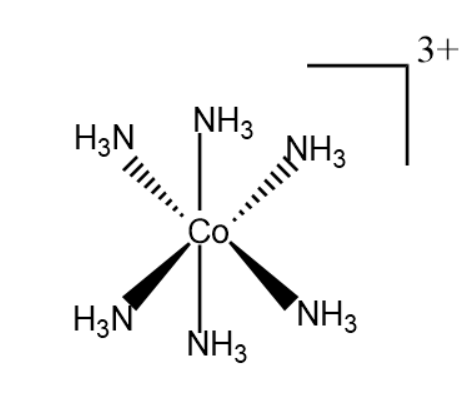
What is a coordination polyhedron?
Answer
421.2k+ views
Hint : Coordinate compounds are the molecules that possess a central metal atom surrounded by ligands through coordinate or dative bond. Here central metal acts as lewis acid and accepts the electron from ligands that act like lewis base. Alfred Werner was the first person to propose his insight on the coordination compounds. These compounds retain their identity in crystal lattice as well as solution or molten state. Example-
Complete Step By Step Answer:
Werner explained that coordination compounds possess 2 types of valency-Primary and secondary valency. Primary valency is ionisable, shows the oxidation state or charge on the complex and shown by dashed line. Secondary valency is non-ionisable, it decides geometry or shape of molecule and shown by solid line. Primary valency is non-directional while secondary valency is directional.
Example-
Central metal atom is generally 1st, 2nd or 3rd period transition elements. The ligands can be all those molecules which have either lone pair or negative charge to donate.
Monodentate ligand-Only 1 donor site in the ligand. For Example- Ammonia
Bidentate ligand-2 donor site in the ligand. For Example-oxalate
Polydentate ligand-More than 2 donor atoms. For Example-EDTA (Ethylene diamine tetra acetate) is hexadentate ligand.
Here Coordination polyhedron refers to the spatial geometry or arrangements of ligands around the central metal atom of the coordination compounds i.e. these ligands are attached to the central atom in space in a definite direction. It may be either octahedral, tetrahedral, trigonal bipyramidal, square pyramidal or of square planar shapes.
Example-



Note :
Ligands mostly act as donors while sometimes ligand can accept the electrons from metal by pi back bonding in
Complete Step By Step Answer:
Werner explained that coordination compounds possess 2 types of valency-Primary and secondary valency. Primary valency is ionisable, shows the oxidation state or charge on the complex and shown by dashed line. Secondary valency is non-ionisable, it decides geometry or shape of molecule and shown by solid line. Primary valency is non-directional while secondary valency is directional.
Example-
Central metal atom is generally 1st, 2nd or 3rd period transition elements. The ligands can be all those molecules which have either lone pair or negative charge to donate.
Monodentate ligand-Only 1 donor site in the ligand. For Example- Ammonia
Bidentate ligand-2 donor site in the ligand. For Example-oxalate
Polydentate ligand-More than 2 donor atoms. For Example-EDTA (Ethylene diamine tetra acetate) is hexadentate ligand.
Here Coordination polyhedron refers to the spatial geometry or arrangements of ligands around the central metal atom of the coordination compounds i.e. these ligands are attached to the central atom in space in a definite direction. It may be either octahedral, tetrahedral, trigonal bipyramidal, square pyramidal or of square planar shapes.
Example-



Note :
Ligands mostly act as donors while sometimes ligand can accept the electrons from metal by pi back bonding in
Recently Updated Pages
Master Class 12 Business Studies: Engaging Questions & Answers for Success

Master Class 12 English: Engaging Questions & Answers for Success

Master Class 12 Social Science: Engaging Questions & Answers for Success

Master Class 12 Chemistry: Engaging Questions & Answers for Success

Class 12 Question and Answer - Your Ultimate Solutions Guide

Master Class 11 Economics: Engaging Questions & Answers for Success

Trending doubts
Draw a labelled sketch of the human eye class 12 physics CBSE

a Tabulate the differences in the characteristics of class 12 chemistry CBSE

Which one of the following is a true fish A Jellyfish class 12 biology CBSE

Why is the cell called the structural and functional class 12 biology CBSE

Differentiate between homogeneous and heterogeneous class 12 chemistry CBSE

Write the difference between solid liquid and gas class 12 chemistry CBSE




